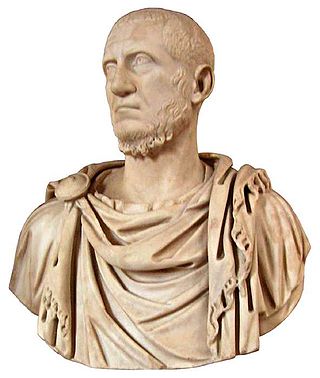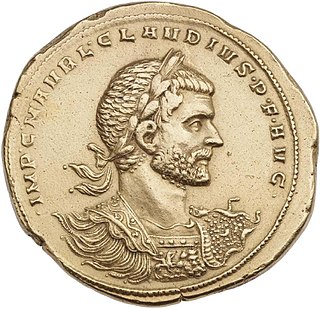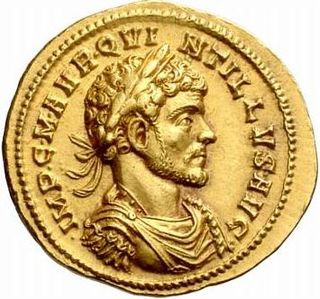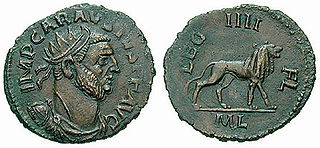Related Research Articles

Publius Licinius Egnatius Gallienus was Roman emperor with his father Valerian from 253 to 260 and alone from 260 to 268. He ruled during the Crisis of the Third Century that nearly caused the collapse of the empire. He won numerous military victories against usurpers and Germanic tribes, but was unable to prevent the secession of important provinces. His 15-year reign was the longest in half a century.

Marcus Claudius Tacitus was Roman emperor from 275 to 276. During his short reign he campaigned against the Goths and the Heruli, for which he received the title Gothicus Maximus.
The 270s decade ran from January 1, 270, to December 31, 279.

Aurelian was a Roman emperor, who reigned during the Crisis of the Third Century, from 270 to 275. As emperor, he won an unprecedented series of military victories which reunited the Roman Empire after it had nearly disintegrated under the pressure of barbarian invasions and internal revolts. Born in modest circumstances, most likely in Moesia Superior, he entered the Roman army in 235 and climbed up the ranks. He went on to lead the cavalry of the emperor Gallienus, until Gallienus' assassination in 268. Following that, Claudius Gothicus became emperor until his own death in 270. Claudius' brother Quintillus ruled the empire for three months, before Aurelian became emperor.

Marcus Aurelius Claudius "Gothicus", also known as Claudius II, was Roman emperor from 268 to 270. During his reign he fought successfully against the Alemanni and decisively defeated the Goths at the Battle of Naissus. He died after succumbing to a "pestilence", possibly the Plague of Cyprian that had ravaged the provinces of the Empire.

The Gallic Empire or the Gallic Roman Empire are names used in modern historiography for a breakaway part of the Roman Empire that functioned de facto as a separate state from 260 to 274. It originated during the Crisis of the Third Century, when a series of Roman military leaders and aristocrats declared themselves emperors and took control of Gaul and adjacent provinces without attempting to conquer Italy or otherwise seize the central Roman administrative apparatus.

Marcus Aurelius Claudius Quintillus was a Roman emperor. He was a brother of Emperor Claudius Gothicus, whom he succeeded after Claudius' death in 270. Quintillus' claim to be emperor was challenged by Aurelian, who was proclaimed emperor by the legions he commanded. Quintillus' reign lasted no more than six months. Different sources report his cause of death as murder by his own soldiers, in battle with Aurelian, or by suicide.

Marcus Cassianius Latinius Postumus was a Roman commander of Batavian origin, who ruled as emperor of the splinter state of the Roman Empire known to modern historians as the Gallic Empire. The Roman army in Gaul threw off its allegiance to Gallienus around the year 260, and Postumus assumed the title and powers of Emperor in the provinces of Gaul, Germania, Britannia, and Hispania. He ruled for the better part of ten years before he was murdered by his own troops.

Marcus Aurelius Marius was emperor of the Gallic Empire in 269 following the assassination of Postumus.

Laelian, also incorrectly referred to as Lollianus and Aelianus, was a usurper against Postumus, the emperor of the Gallic Empire. His revolt lasted from approximately late February to early June 269.

Domitian II was a Roman soldier of the mid 3rd century who was acclaimed emperor, probably in northern Gaul in late 270 or early 271, and struck coins to advertise his elevation. It is now generally assumed that this man is to be equated with the Domitianus who is twice mentioned in the literary sources as a significant figure in the politics of the age, but on neither occasion as an outright contender for the Imperial throne.

Marcus Piavonius Victorinus was emperor in the Gallic provinces from 268 to 270 or 269 to 271, following the brief reign of Marius. He was murdered by a jealous husband whose wife he had tried to seduce.

Gaius Pius Esuvius Tetricus was the emperor of the Gallic Empire from 271 to 274 AD. He was originally the praeses (governor) of Gallia Aquitania and became emperor after the murder of Emperor Victorinus in 271, with the support of Victorinus's mother, Victoria. During his reign, he faced external pressure from Germanic raiders, who pillaged the eastern and northern parts of his empire, and the Roman Empire, from which the Gallic Empire had seceded. He also faced increasing internal pressure, which led him to declare his son, Tetricus II, caesar in 273 and possibly co-emperor in 274, although this is debated. The Roman emperor Aurelian invaded in 273 or 274, leading to the Battle of Châlons, at which Tetricus surrendered. Whether this capitulation was the result of a secret agreement between Tetricus and Aurelian or necessary after his defeat is debated. Aurelian spared Tetricus, and even made him a senator and corrector (governor) of Lucania et Bruttium. Tetricus died of natural causes a few years after 274.

Gaius Pius Esuvius Tetricus was the son of Tetricus I, Emperor of the Gallic Empire (270/271-273/274).

Septimius Vaballathus was emperor of the Palmyrene Empire centred at Palmyra in the region of Syria. He came to power as a child under his regent mother Zenobia, who led a revolt against the Roman Empire and formed the independent Palmyrene Empire.
Felicissimus was a public officer in Ancient Rome, during the reign of Emperor Aurelian. He is famous because he led an uprising of mint workers against the Emperor, but was defeated and killed, possibly in 274, but more probably in 271.

The Carausian revolt (AD 286–296) was an episode in Roman history during which a Roman naval commander, Carausius, declared himself emperor over Britain and northern Gaul. His Gallic territories were retaken by the western Caesar Constantius Chlorus in 293, after which Carausius was assassinated by his subordinate Allectus. Britain was regained by Constantius and his subordinate Asclepiodotus in 296.

Jotapian was a usurper in the eastern provinces of the Roman Empire during the reign of Emperor Philip the Arab, around 249. Jotapian is known from his rare coins and from accounts in Aurelius Victor, Zosimus, and Polemius Silvius (Laterculus).
Aurelius Achilleus was a rebel against the Roman emperor Diocletian in Egypt in 297 AD.
References
- 1 2 3 4 Polfer (1999).
- 1 2 3 Aurelius Victor 35.4, cited in Polfer (1999).
- 1 2 Eutropius, Breviarium 9.10-13.
- 1 2 3 Polemius Silvius, Laterculus 49, cited in Polfer (1999).
- ↑ Orosius, Historiarum adversus paganos VII.23.5, cited in Polfer (1999).
- ↑ König, I. (1981). Die gallischen Usurpatoren von Postumus bis Tetricus . München. p. 181. ISBN 9783406048012.
{{cite book}}: CS1 maint: location missing publisher (link), cited in Polfer (1999), who objects that by this timeline, Faustinus should have had time to strike his own coins, but none have been found. - ↑ Stevens, C. E. (1966), "The social and economic aspect of rural settlement", Rural settlement in Roman Britain, CBA Research reports 7, C. Thomas (ed.), London, p. 122
{{citation}}: CS1 maint: location missing publisher (link), cited in Polfer (1999).